Signs, Symptoms, and Support of Uterine Fibroids
Kelly Ruef, ND
Signs, Symptoms, and Support of Uterine Fibroids
by Kelly Ruef, ND
It is estimated that up to 70% of women will have at least one uterine fibroid in their lifetime. Luckily, not every woman will be symptomatic, and many will never know they have (or had) a fibroid. But for the women who are symptomatic (struggling with heavy bleeding, spotting, menstrual cramping, iron deficiency anemia, constipation, etc.) DUTCH testing may be helpful in identifying factors that are contributing to the fibroid occurrence and growth.
In this blog, we will cover risk factors, estrogen’s role, and DUTCH Test patterns and markers that may be associated with uterine fibroids.
What are Uterine Fibroids?
Uterine fibroids (also called uterine leiomyomas) are solid tumors that grow in the uterus. They are usually noncancerous and pose no increased risk for uterine cancer. Fibroids can protrude into the uterine cavity, grow on the outside of the uterus, or grow within the uterine muscle wall. Usually, there is more than one fibroid present at a time.
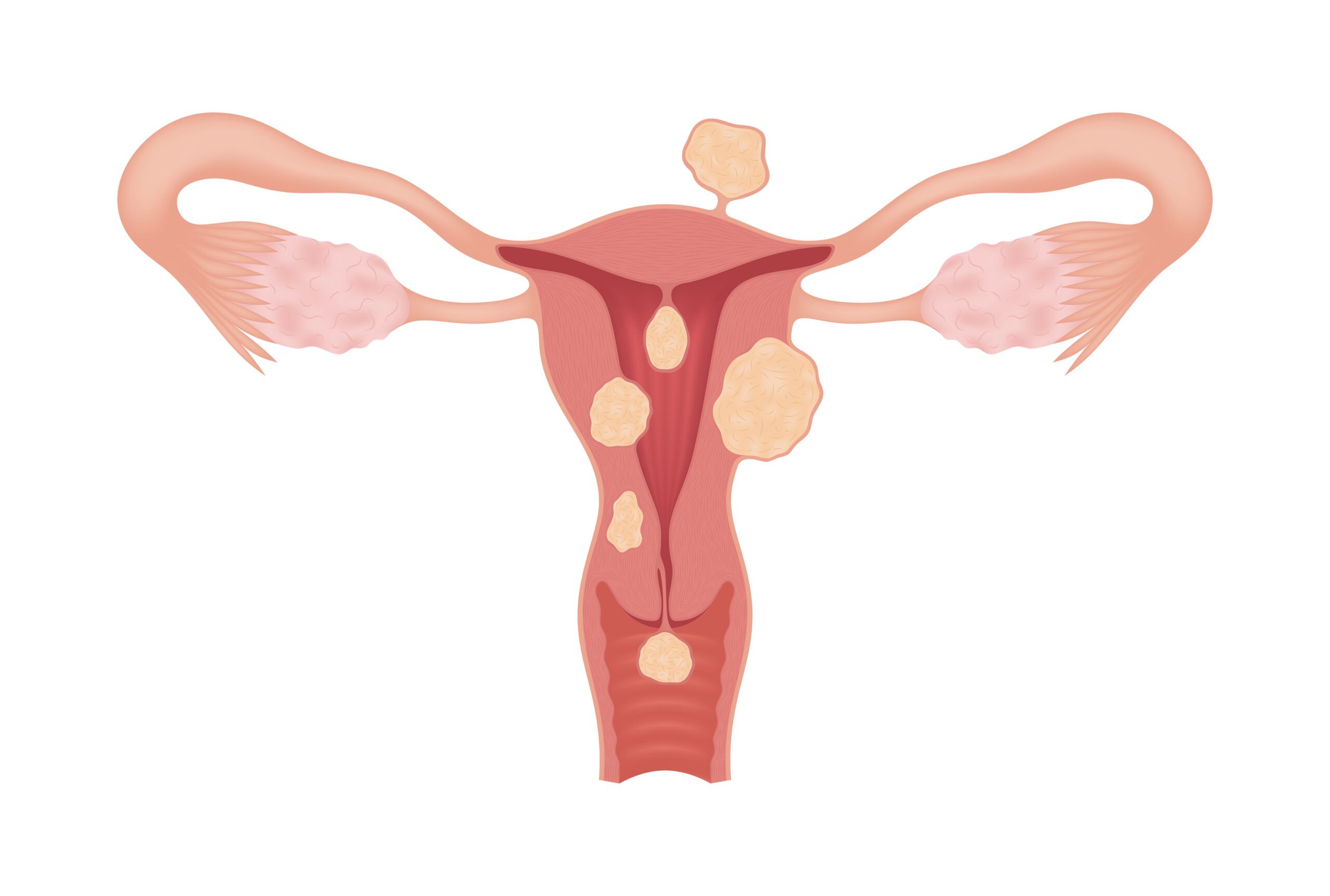
Some fibroids are very small—think the size of a grain of rice. Others are very large—closer to the size of a melon. Some do not cause symptoms, while others can result in heavy menses, clots, spotting, intermenstrual bleeding, menstrual cramping and pain, iron deficiency anemia, urinary frequency, and/or constipation. Symptoms tend to depend on the quantity, size, and location of the fibroid(s).
It’s uncertain what causes uterine fibroids, but hormones and genetics likely play a role.
Factors that Increase Risk for Fibroids
- Increasing age
- Black race
- Early menarche (<10 years old)
- Oral contraceptives at an early age (13-16 years old)
- Family history of fibroids
- No previous pregnancies or births
- High blood pressure
- Obesity
- Chronic psychological stress
- Vitamin D deficiency
- Exposure to phthalates, polychlorinated bisphenols (PCBs), bisphenol A (BPA), and/or diethylstilbestrol (DES)
- Beef and other red meats, ham
- Omega-3 fatty acids (or environmental pollutants associated with this type of fat)
- Food additive consumption
- Alcohol, especially beer

Factors that Decrease Risk for Fibroids
- Pregnancy (more pregnancies = decreased risk)
- Long-term use of oral or injectable contraceptives
- Green vegetables
- Fruit, especially citrus fruits
- Vitamin A from animal sources
Estrogen’s Role in Uterine Fibroids
Estrogen likely plays an important role in the development and growth of fibroids. We know that fibroids are estrogen-dependent because there has never been a case of a prepubertal girl with uterine fibroids, and fibroids often shrink after a woman goes through menopause. Fibroids tend to have more estrogen receptors, so this may be one reason estrogen disproportionately affects the growth of these solid tumors.
DUTCH Test Patterns and Markers Associated with Uterine Fibroids
Elevated Estrogen
As estrogen can fuel the growth of fibroids, it may be helpful to identify whether a patient has elevated estrogen on the DUTCH Test.
Estradiol (E2) is the most biologically active estrogen in the body. However, estrone (E1) and the phase 1 estrogen metabolites (2-OH, 4-OH, 16-OH) can also bind to estrogen receptors. Thus, it is possible that elevations in any of these markers may contribute to fibroid growth.
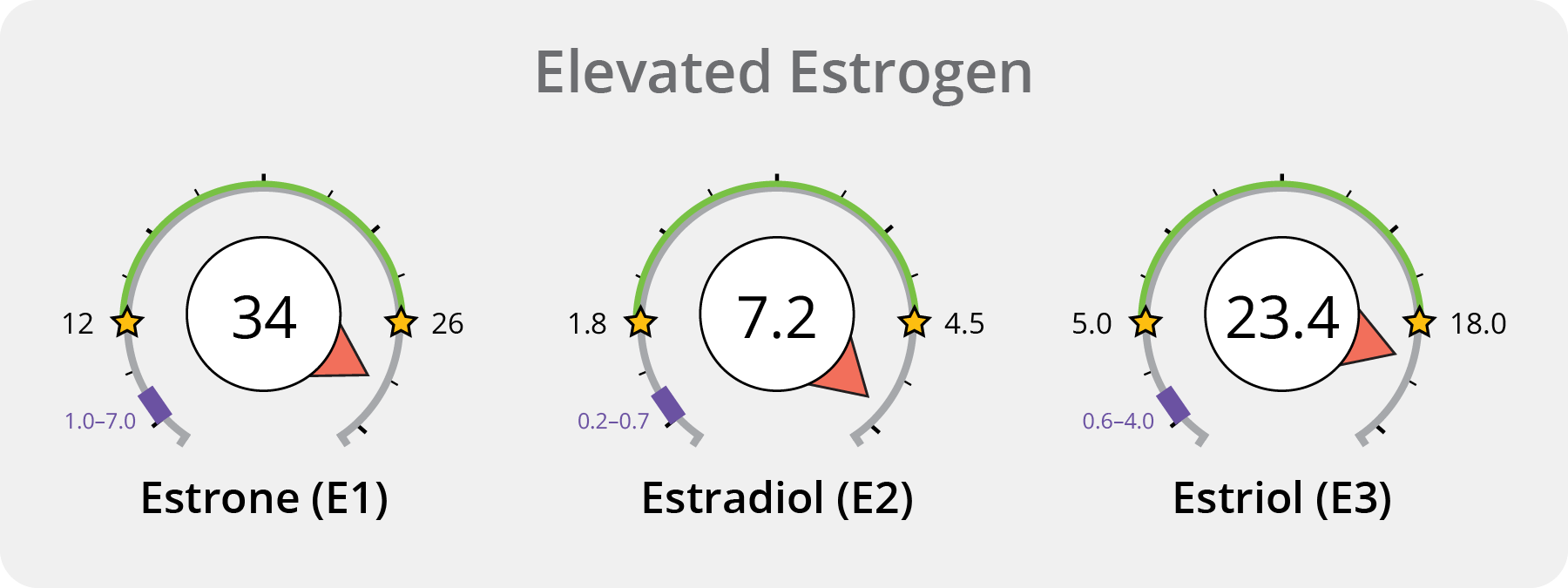
Elevated 16-OH-E1
The phase 1 metabolite, 16-OHE1, tends to bind more tightly to estrogen receptors than the 2-OH and 4-OH metabolites (but not nearly as tightly as E2), and is known to cause tissue proliferation. If too much estrogen is metabolized into the 16-OHE1 form, it may contribute to increased fibroid growth. Consider encouraging estrogen down the most stable 2-OH pathway by recommending a low-sugar diet, cruciferous vegetables, apiaceae (carrot) family vegetables, rosemary, fish oil, soy, and flaxseeds to patients with fibroids.
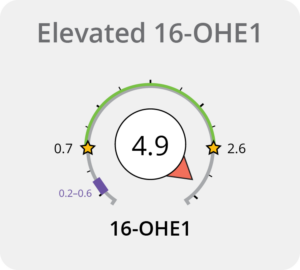

Elevated Quinolinate
Urinary phthalate metabolite concentrations have been positively correlated with urinary quinolinate concentration. As phthalate exposure is a risk factor for fibroids, quinolinate may be an important organic acid marker on the DUTCH Test to keep an eye on.
HPA Axis Dysfunction
Chronic psychological stress can increase a woman’s risk for uterine fibroids; thus it may be helpful when considering treatment and prevention options to assess a woman’s HPA axis health. Chronic psychological stress may present as elevated cortisol but can also present as low cortisol.
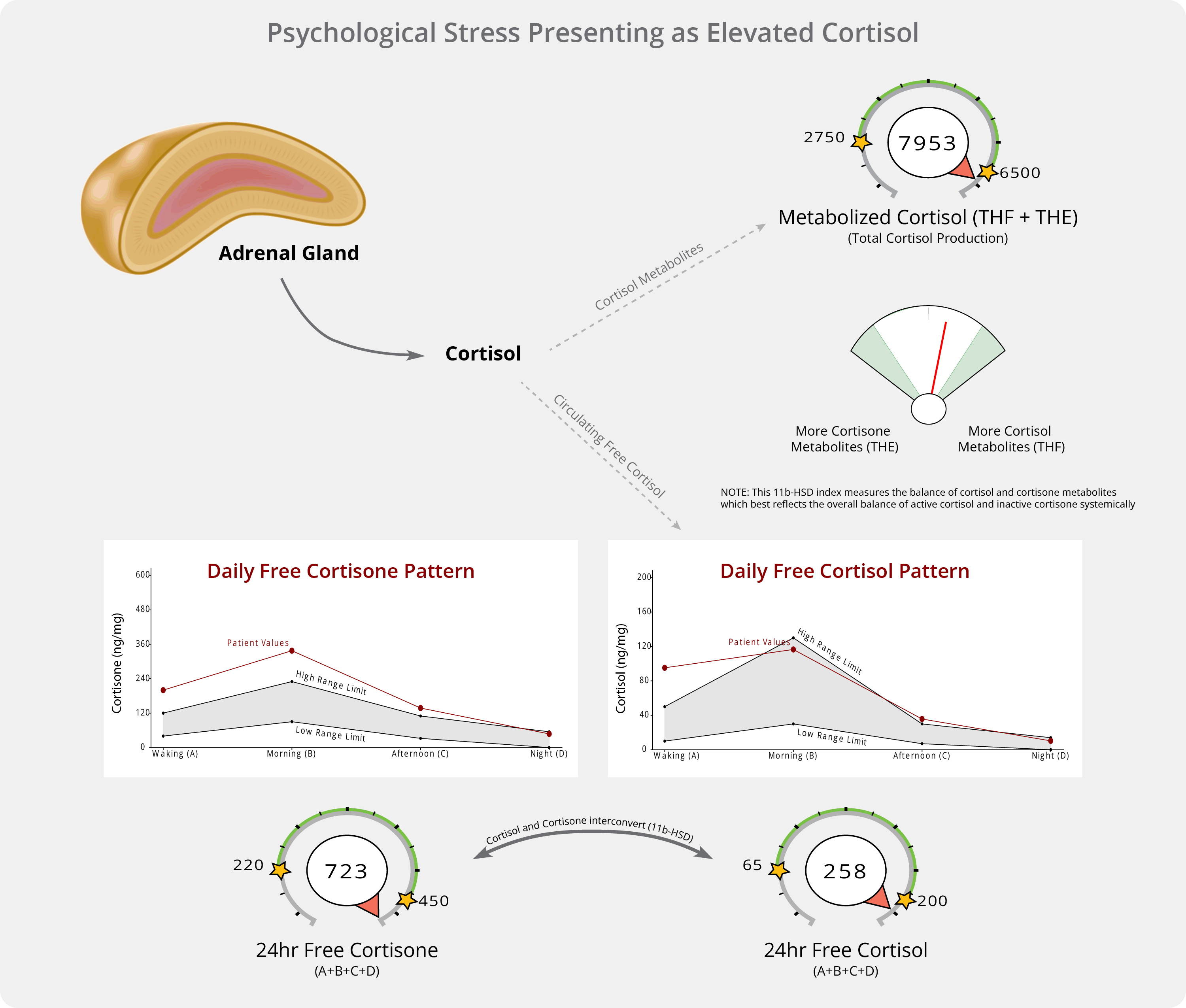
Psychological stress presenting as elevated cortisol.
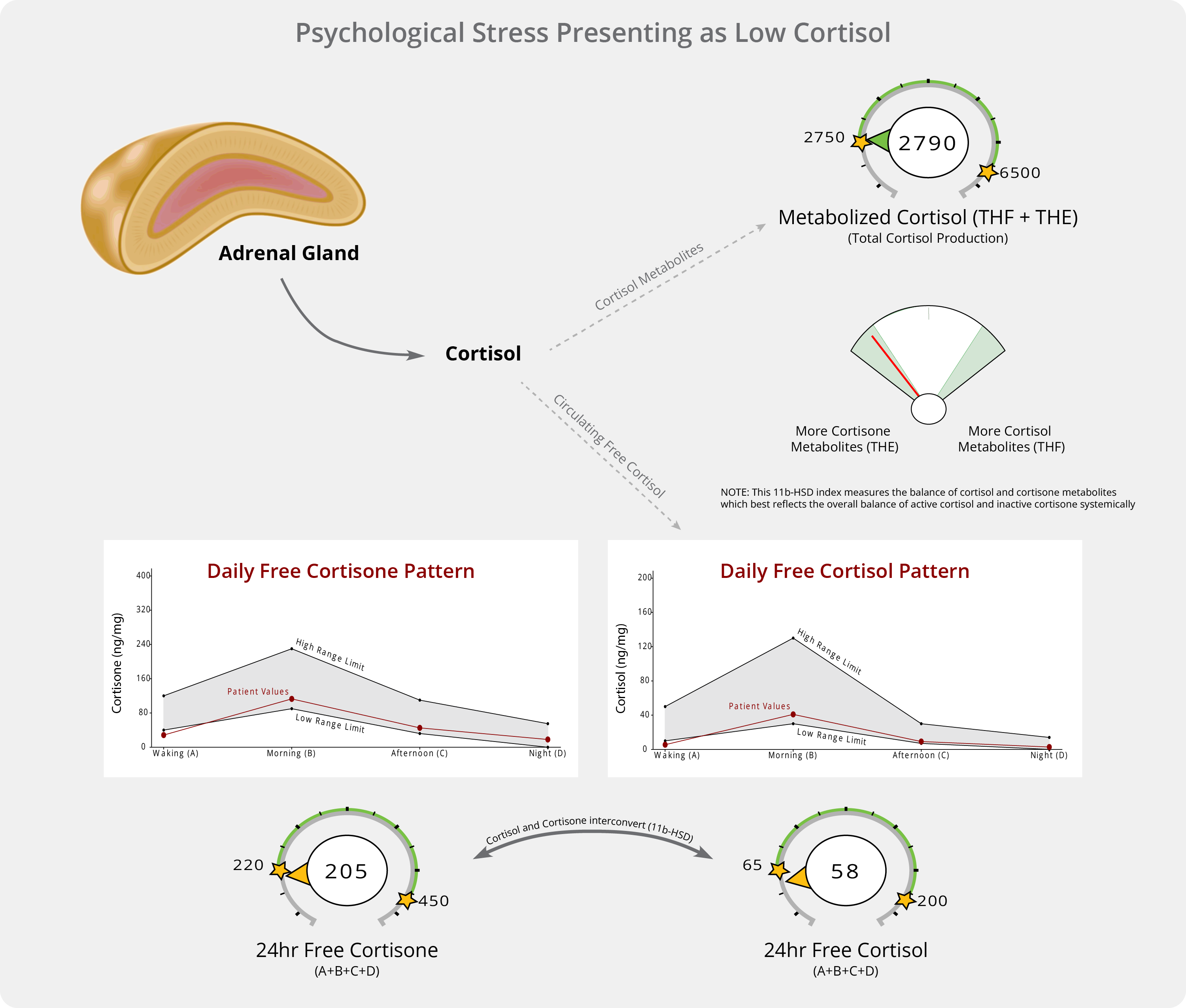
Psychological stress presenting as low cortisol.
Patterns of Obesity
As obesity is a risk factor for fibroids, it may be helpful to identify if there are any patterns often seen with obesity on the DUTCH Test, such as:
- Elevated estrogen
- Upregulated 5a-reductase
- Upregulated aromatase (testosterone and androstenedione, E2 and E1, respectively)
- Estrogen clearance favoring 16-OHE1
- Elevated cortisol metabolism
- Low free cortisol
- Cortisol metabolism favoring THF when acute and THE when chronic
- Elevated methylmalonate (deficient B12)
- Low melatonin
Using DUTCH to Monitor and Manage Fibroids
There are various risk factors and DUTCH Test patterns that practitioners can keep an eye on when treating a woman who is struggling with uterine fibroids. The DUTCH Test enables practitioners to formulate more personalized treatment protocols that not only can help slow the growth of fibroids, but also lower the risk for future occurrences.
You can learn more about the DUTCH Test and uterine fibroids by watching the DUTCH March webinar on uterine fibroids by Dr. Kelly Ruef, click here to register.
- Baird DD, et al. Vitamin d and the risk of uterine fibroids. Epidemiology. 2013 May;24(3):447-53. PMID: 23493030
- Borahay MA, et al. Estrogen Receptors and Signaling in Fibroids: Role in Pathobiology and Therapeutic Implications. Reprod Sci. 2017 Sep;24(9):1235-1244. PMID: 27872195
- Eltoukhi HM, et al. The health disparities of uterine fibroid tumors for African American women: a public health issue. Am J Obstet Gynecol. 2014 Mar;210(3):194-9. PMID: 23942040
- Jacobson, John D. “Uterine Fibroids.” MedlinePlus , U.S. National Library of Medicine, 10 Jan. 2022, https://medlineplus.gov/ency/article/000914.htm
- Kwas K, et al. Impact of Contraception on Uterine Fibroids. Medicina (Kaunas). 2021 Jul 16;57(7):717. PMID: 34356998
- Marshall LM, et al. A prospective study of reproductive factors and oral contraceptive use in relation to the risk of uterine leiomyomata. Fertil Steril. 1998 Sep;70(3):432-9. PMID: 9757871
- Nassan FL, et. al. Association of urinary concentrations of phthalate metabolites with quinolinic acid among women: A potential link to neurological disorders. Environ Int. 2020 May;138:105643. PMID: 32179323
- Raley E, et al. Chemical Exposures via Personal Care Products and the Disproportionate Asthma Burden Among the U.S. Black Population. J Allergy Clin Immunol Pract. 2021 Sep;9(9):3290-3292.
- Stewart EA, et. al. Uterine fibroids (leiomyomas): Epidemiology, clinical features, diagnosis, and natural history. In: UpToDate, Chakrabarti A (Ed), UpToDate, Waltham, MA. (Accessed on Jan 4th 2023.)
TAGS
Women's Health
Premenopausal Women
Fibroids
Estrogen and Progesterone
Estrogen Detoxification
Organic Acids
Estrogen Dominance
HPA Axis
Obesity
Metabolic Health
Dysmenorrhea